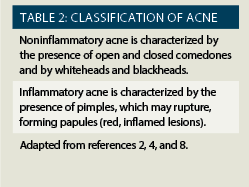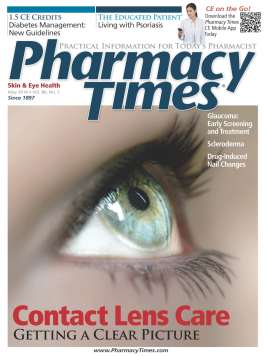Publication
Article
Pharmacy Times
Acne Vulgaris: The Most Common Dermatologic Disorder
Author(s):
Pharmacists are in a pivotal position to help patients select OTC products for managing mild to moderate acne.
Pharmacists are in a pivotal position to help patients select OTC products for managing mild to moderate acne.
According to the American Academy of Dermatology, acne is the most common dermatologic disorder in the United States.1,2
The cause of acne is unknown, but some contributing factors have been identified (Table 12-9), including androgenic hormonal triggers, excessive sebum production, alteration in the keratinization process, and proliferation of Propionibacterium acnes and the resulting inflammatory process.2,4-9 The causes of acne are thought to be multifactorial and greatly influenced by genetic and hormonal factors.2,4-9
Selecting the appropriate product may be overwhelming for some patients, but pharmacists are in a pivotal position for guiding patients regarding OTC products for managing mild to moderate acne. Pharmacy shelves are lined with a plethora of nonprescription topical skin care products for self-treatment and self-management of mild to moderate acne.
In February 2014, the American Academy of Dermatology stated that OTC acne products can be beneficial, and dermatologists often recommend the use of OTC acne products in conjunction with prescription acne products, when appropriate.3 These products are available in various formulations that typically contain the active ingredients benzoyl peroxide (BPO), salicylic acid, or sulfur, or a combination of these ingredients; examples of these products include medicated cleansing bars and pads, liquids, lotions, creams, gels, foams, pads/wipes, and astringents. Several new products have recently been introduced to the market; some examples are Clearasil Ultra Rapid Action Treatment Lotion for Face and Body, Clear and Clean Advantage Daily Soothing Acne Cleanser, Neutrogena Oil-Free Acne Wash Pink Grapefruit Cream Cleanser, and Stridex Conditioning Acne Scrub.

In general, the overall goals of treating acne are to prevent or minimize the incidence of pimples and prevent scarring.1,2 Factors to consider when electing use of an OTC acne product include the type and severity of the acne (Tables 22,4,8 and 31-9 and Online Table 48), patient skin sensitivity, and patient preference.2 In general, mild to moderate cases of acne can be effectively self-treated by adhering to a daily skin care routine including the use of a nonprescription topical acne agent(s) and avoiding factors that may worsen acne flare-ups.2,4,5
Individuals with severe acne and scarring and those who have no improvement or have worsening of acne after using topical nonprescription acne products should be encouraged to seek further medical care from a dermatologist and discuss the various prescription treatments.2,4,5 Those with severe acne may require a combination of therapies, which may include prescription products such as topical retinoids and oral antibiotics.2,4-9
Nonprescription Topical Acne Products
Benzoyl Peroxide
BPO is considered to be the most effective and widely used nonprescription medication for both types of acne.2,3 In OTC products, concentrations of BPO range from 2.5% to 10%.2,3 BPO can prevent or eliminate infection with P. acnes, which is the type of bacteria that cause acne inflammation.2,3 BPO works by removing excess oil from the skin and exfoliating dead skin cells that clog pores.2,3
Patients should be advised that BPO can cause excessive dryness of the skin, burning, and tingling, and to use sunscreen daily and avoid unnecessary sun exposure.2,3 Caution should be used when applying BPO to areas near the lips, nose, and mouth, and around open scrapes or cuts. Because BPO may cause bleaching, contact with hair and clothing should be avoided. Patients should be advised that to see benefits, treatment should be continued for at least 4 to 8 weeks, and they should seek medical advice if acne does not improve or if it worsens after 4 to 8 weeks of therapy.2,3
Salicylic Acid
Salicylic acid is available in many nonprescription topical acne products, and concentrations range from 0.5% to 2%.2,3 Salicylic acid exerts its pharmacologic effect by decreasing shedding of cells inside hair follicles, which prevents clogged pores, and it provides a milder but less effective alternative to prescription topical retinoid products.2,3 Salicylic acid is found in many acne facial washes and cleansers, gels, and medicated pads and creams, and it is often used twice a day. The use of topical salicylic acid has been associated with excessive peeling, burning, stinging, and redness of the skin.2,3 The use of sunscreen and avoidance of unnecessary sun exposure is advised when using products that contain salicylic acid.2,3
Sulfur
Some acne products contain sulfur, which is thought to treat acne by preventing the growth of P. acnes and may also help to remove dead skin cells and excess oil.2,3 Sulfur is often found in combination with resorcinol or sulfacetamide.2,3 Use of sulfur-containing products may cause dryness, redness, and peeling of the skin. These products are typically applied to affected areas 1 to 3 times daily, but use is often limited because of the chalky yellow appearance and noticeable odor.2,3 Products containing resorcinol may cause reversible dark scaling on individuals with darker skin tones.2,3
Closing Thoughts
During the third quarter of 2013, the FDA placed OTC products that contain BPO, salicylic acid, or both on its list of medications to monitor for potentially causing hypersensitivity and anaphylactic reactions; however, the FDA stresses that this does not mean there are any reported health risks.10,11 The FDA emphasizes that health care professionals should not stop recommending the use of these products.10,11 The FDA is continuing to evaluate these products to determine whether regulatory action is needed.10,11
Table 4: Classifying Acne Severity
Severity
Definition
Mild
<20 comedones, <15 inflammatory lesions, or <30 total lesions
Moderate
20 to 100 comedones, 15 to 50 inflammatory lesions, or 30 to 125 total lesions
Severe
>5 cysts, >100 comedones, >50 inflammatory lesion, or >125 total lesions
Adapted from reference 8.
During counseling, patients should be advised to use nonprescription topical acne products as directed and to adhere to treatment (Online Table 52-9). Patients should be encouraged to consult a dermatologist for other treatment options if no signs of improvement are seen after 4 to 8 weeks of treatment with these products.2,3 It is imperative that patients with severe acne and scarring be referred to a dermatologist to discuss other treatment options or recommendations, when warranted.
Table 5: Acne Counseling Tips
- When outdoors, always wear sunscreen to protect the skin.
- Keep hair off your face, and shampoo your hair daily if it is oily.
- Always seek medical care for acne that does not respond to OTC acne medications.
- To prevent scarring, never squeeze, pinch, or pick acne lesions.
- To prevent irritation of acne, avoid scrubbing when cleaning the skin.
- Establish a skin care routine by washing your face at least twice a day with a soft washcloth, warm water, and an appropriate mild facial cleanser.
- Always cleanse the skin properly after exercising or sweating.
- To prevent flare-ups, when possible, use only oil-free skin and hair care products and cosmetics labeled noncomedogenic.
Adapted from references 2-9.
Ms. Terrie is a clinical pharmacy writer based in Haymarket, Virginia.
References
- Acne. American Academy of Dermatology website. www.aad.org/media-resources/stats-and-facts/conditions/acne. Accessed March 28, 2014.
- Foster K, Coffey C. Acne. In: Krinsky DL, Berardi RR, Ferreri SP, et al, eds. Handbook of Nonprescription Drugs: An Interactive Approach to Self-Care. 17th ed. Washington, DC: American Pharmacists Association; 2011.
- Dermatologists advise patients that over-the-counter acne products can have benefits and a place on their medicine shelf. American Academy of Dermatology website. www.aad.org/stories-and-news/news-releases/dermatologists-advise-patients-that-over-the-counter-acne-products-can-have-benefits-and-a-place-on-their-medicine-shelf. Accessed March 30, 2014.
- Fulton J Jr. Acne vulgaris. Medscape website. http://emedicine.medscape.com/article/1069804-overview. Accessed March 26 2014.
- Tailored acne treatments help women address adult acne with added benefit of improving aging skin. American Academy of Dermatology website. www.aad.org/stories-and-news/news-releases/tailored-acne-treatments-help-women-address-adult-acne-with-the-added-benefit-of-improving-aging-skin. Accessed March 29, 2014.
- Thielitz A. Overview of new therapeutic developments for acne. Medscape website. www.medscape.com/viewarticle/587306. Accessed March 27, 2014.
- Savage LJ, Layton AM. Treating acne vulgaris: systemic, local and combination therapy. Expert Rev Clin Pharmacol. 2010;3(4):563-580.
- Acne vulgaris. Merck Manual for Healthcare Professionals Online Edition website. www.merckmanuals.com/professional/dermatologic_disorders/acne_and_related_disorders/acne_vulgaris.html. Accessed March 27, 2014.
- Acne. Medline Plus website. www.nlm.nih.gov/medlineplus/ency/article/000873.htm. Accessed March 28, 2014.
- Potential signals of serious risks/new safety information identified by the FDA Adverse Event Reporting System (FAERS) between July — September 2013. FDA website. www.fda.gov/Drugs/GuidanceComplianceRegulatoryInformation/Surveillance/AdverseDrugEffects/ucm376571.htm. Accessed March 30, 2014.
- Lowes R. OTC acne products make FDA watch list. Medscape website. www.medscape.com/viewarticle/819915. Accessed March 30, 2014.







